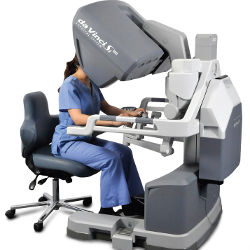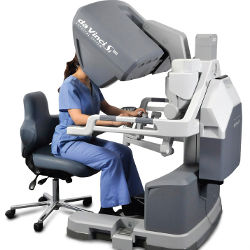
The term “Surgical Robots” is, in essence, a bit of a misnomer. Whereas robots generally are able to operate without any human intervention, surgical “robots” are essentially devices that augment and assist surgeons during procedures by enhancing the facility, vision, and accuracy of human surgeons. Based on the widespread utilization of Intuitive Surgical, Inc.’s da Vinci Surgical System—it has been deployed to more than 2,500 hospitals around the world since its commercialization in 2001—surgeons and patients have embraced the technology.
According to the company, the da Vinci system has been used for a variety of gynecologic, transoral, cardiac, thoracoscopic, and thoracoscopically assisted cardiac procedures, providing an alternative to open or laparoscopic procedures.
Robot or Intelligent Assistant?
The da Vinci system is not a fully autonomous robotic device; it is designed to augment and assist the surgeon, rather than to carry out a surgical procedure autonomously. In a typical procedure using the da Vinci system, the patient lies on a side cart during surgery, while the surgeon sits at a control console facing a high-definition 3D vision system and manipulates four interactive robotic arms with proprietary surgical instruments attached to the end of each arm. The computer-enhanced system allows the surgeon to use intuitive motion (that is, instruments move in the same direction as their hand naturally turns), which is an advantage over laparoscopic surgery, in which the instruments must be moved by the surgeon in the opposite direction.
All incisions and maneuvers are ultimately controlled by the surgeon in real time, with the system providing enhanced control over these actions, rather than directing them. However, specially programmed controllers and sensors measure and calibrate the force and distance of the surgeon’s motions, allowing the robot’s arm motion to be scaled to move a fraction of an inch for every inch the surgeon’s hand moves. This simplifies the most complex movements during resections, suturing, and knot-tying, and eliminates any natural tremors associated with free-hand surgery.
“With proper training, oversight, and clinical expertise, robotic surgery is safe, and in select surgical cases provides the benefit to the patient.”
Like laparoscopic surgery, robotic surgical procedures are deemed to be minimally invasive. With traditional open surgery, a large opening must be cut into the patient to allow the surgeon enough room to operate. With the da Vinci system, several holes, or ports, are made in the patient’s body, through which the instruments are inserted. This allows for a significantly smaller incision (up to 6 to 8 centimeters or roughly 2.5 to 3 inches, though often smaller) to be made, compared with traditional open surgical procedures, which can require incisions of 15–20 centimeters (6 to 8 inches) or more.
The most advanced version of Intuitive’s surgical system, the da Vinci Xi System, was approved for use by the U.S. Food and Drug Administration (FDA) in March 2014, and features a unique surgical arm that is thinner and smaller than ever before, allowing for a smaller incision, and which can rotate 180 degrees, providing greater maneuverability.
Intuitive Surgical, however, is not the only market participant. Mako Surgical Inc.’s RIO Robotic Arm Interactive Orthopedic System debuted in 2006 to help surgeons conduct orthopedic knee and hip procedures. Titan Medical Inc.’s SPORT (Single Port Orifice Robotic Technology) Surgical System is currently in the testing phase, and is expected to receive FDA approval by the end of 2015.
The Human Factor
Because the da Vinci system (and other similar systems) is not fully autonomous, the successful outcome of a surgical procedure is still based largely on the skill and experience of the surgeon and his or her support team, rather than blind reliance on technology. According to a study published in The Journal for Healthcare Quality in September 2013, 174 injuries and 71 deaths have been reported in relation to da Vinci system surgeries.
“As with any other tool, the experience counts,” says Dr. Seth Lerner, director of the prostate program at the Dickstein Cancer Treatment Center at White Plains Hospital Center in White Plains, NY. “With proper training, oversight, and clinical experience, robotic surgery is safe, and in select surgical cases provides the benefit to the patient.”
Some of the key issues involve the lack of both tactile sensation and tensile feedback to the surgeon, given that the surgeon is not directly connected to the instruments inside the body. As a result, tissue damage can occur unintentionally during movement of the robotically controlled instrument. Additionally, while the high-tech 3D vision system may provide greater “up close” views, it does not allow for a larger frame of reference covering the entire surgical site, thereby impeding a more holistic picture of the surgery, compared with traditional surgical procedures.
Most importantly, the use of any type of robotic surgical device can involve a steep learning curve, particularly for surgeons trained primarily in open surgical procedures. While Intuitive Surgical did not respond to multiple requests for comment, it does have a surgeon training program in place designed to ensure those using the technology know how to safely use the device prior to operating on patients. Nevertheless, patient safety ultimately is the responsibility of the provider, Lerner says.
“While Intuitive Surgical has aggressively marketed the instrument, it is still up to the individual provider to know what they should and should not do,” Lerner says. “What we set up at our institution is significant oversight, having 10 proctored cases at a minimum and thereafter, careful accounting of the outcomes. I think when that is embraced, it becomes a safer approach to utilizing any new technology.”
“Our institution has erred on the conservative side, with 10 proctored cases, and that has markedly reduced the incidence of adverse outcomes,” Lerner says.
Titan Medical, the developer of the SPORT Surgical System, which is designed to provide similar functionality to the da Vinci system at a lower price point, while also using a single port to access the surgical site, says that installing an adequate training program is paramount to ensuring the best outcomes.
“First and foremost, we will build as much safety as we can into SPORT,” Titan Medical CEO John Hargrove says. “Right now, there does not seem to be a standard of training, as far as training with robotics is concerned. As we go to market, we are going to incorporate a vigorous training program into the utilization of the SPORT Robotics system,” Hargrove says, noting that in future generations of the SPORT system, surgeons will be able to train for future procedures on the device itself using a software-based simulator.
A Robotic Knife That Doesn’t Cut
Another type of robotic surgical technology being used today is Accuray’s CyberKnife system. Unlike the da Vinci, SPORT, or RIO robotic surgical systems, the CyberKnife uses computer-controlled robotic mobility and high-intensity radiation to target tumors in the body, rather than physically cutting them out.
With the CyberKnife system, a physician determines the appropriate level of radiation to deliver, and a planning algorithm is used to determine the best way to eradicate the tumor. The physician then reviews the plan, and once he or she is satisfied, the CyberKnife system takes over, automatically firing heavy doses of targeted radiation directly at a tumor, in a technique called ablation.
“Unlike the Intuitive Surgical da Vinci system, where the surgeon is actually driving the robot during the surgery, in the case of the CyberKnife system, it is fully automated,” says Robert Hill, SVP of Engineering at Accuray. “There is a vision system that can see where the tumor is, and then the robot itself basically targets the radiation, beaming very precisely to make sure that tumor is treated properly.”
“What it does is it destroys the cells themselves,” Hill continues, contrasting ablation with traditional radiation therapies in which lower doses of radiation are used to modify the DNA of cancerous cells so they can no longer replicate in the body.
Tumors often move or shift position (up to 1.5 centimeters over a 30-minute period), and in order to deliver radiation safely, the robot must know exactly where the tumor is at all times. Using imaging technology called InTempo, the CyberKnife system captures images of the tumor’s position less frequently when the tumor is stationary, to reduce the amount of radiation unnecessarily delivered to the patient. When the tumor begins to move, the system increases the frequency of imaging, allowing it to track the tumor and deliver radiation precisely.
The advantage of the fully automated CyberKnife system is that it is completely noninvasive. “We don’t actually pierce the skin with a scalpel or cutting instrument.”
“The system itself delivers radiation to less than 1mm of accuracy, and then we also account for motion of the target that we are trying to treat,” Hill says, noting that because the system is more accurate in the targeting of a tumor, compared with traditional imaging systems, “we can deliver more radiation dose in each treatment session.”
While the InTempo imaging system is designed to mitigate the risk of errant radiation, Accuray admits there is still potential for some radiation to be inadvertently delivered to adjacent healthy organs or tissue in the body.
The largest benefits of the CyberKnife system, according to Hill, include reduced pain, faster recovery times, and little to no chance of surgical infections. “In general, the advantage for our type of treatments is that they’re completely noninvasive,” Hill says. “We don’t actually pierce the skin with a scalpel or cutting instrument. What that means is there is generally no pain, or very limited pain associated with the procedure, and the recovery times are much better compared with traditional surgery.”
Further Reading
Robotically Assisted vs Laparoscopic Hysterectomy Among Women With Benign Gynecologic Disease. JAMA. 2013;309(7):689-698Jason D. Wright, MD; Cande V. Ananth, PhD, MPH; Sharyn N. Lewin, MD; William M. Burke, MD; Yu-Shiang Lu, MS; Alfred I. Neugut, MD, PhD; Thomas J. Herzog, MD; Dawn L. Hershman, MD, at http://jama.jamanetwork.com/article.aspx?articleid=1653522
What is Robotic Surgery?: http://robotic-surgery.med.nyu.edu/for-patients/what-robotic-surgery
Video
Robotic Surgery demonstration: https://www.youtube.com/watch?v=VJ_3GJNz4fg





Join the Discussion (0)
Become a Member or Sign In to Post a Comment